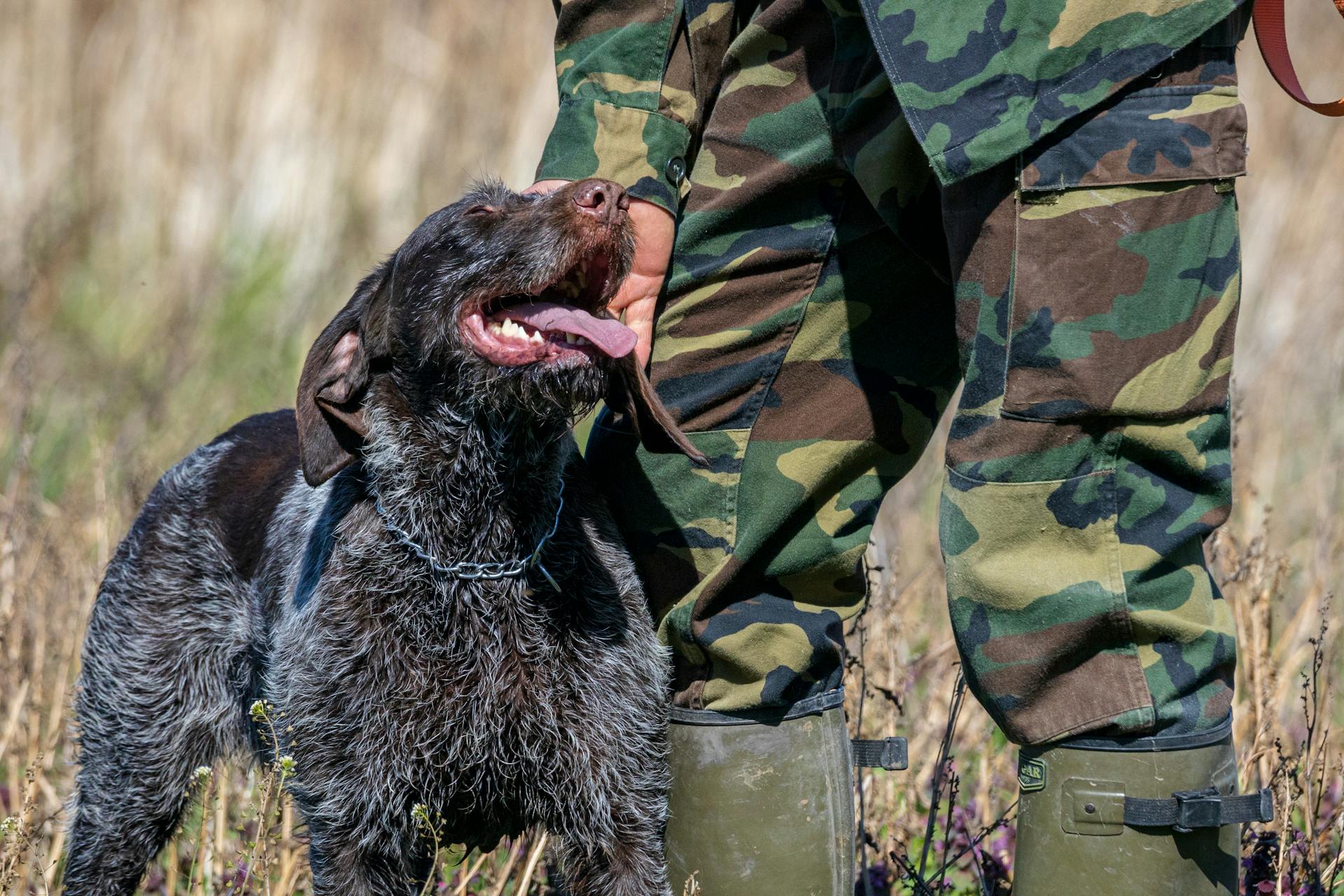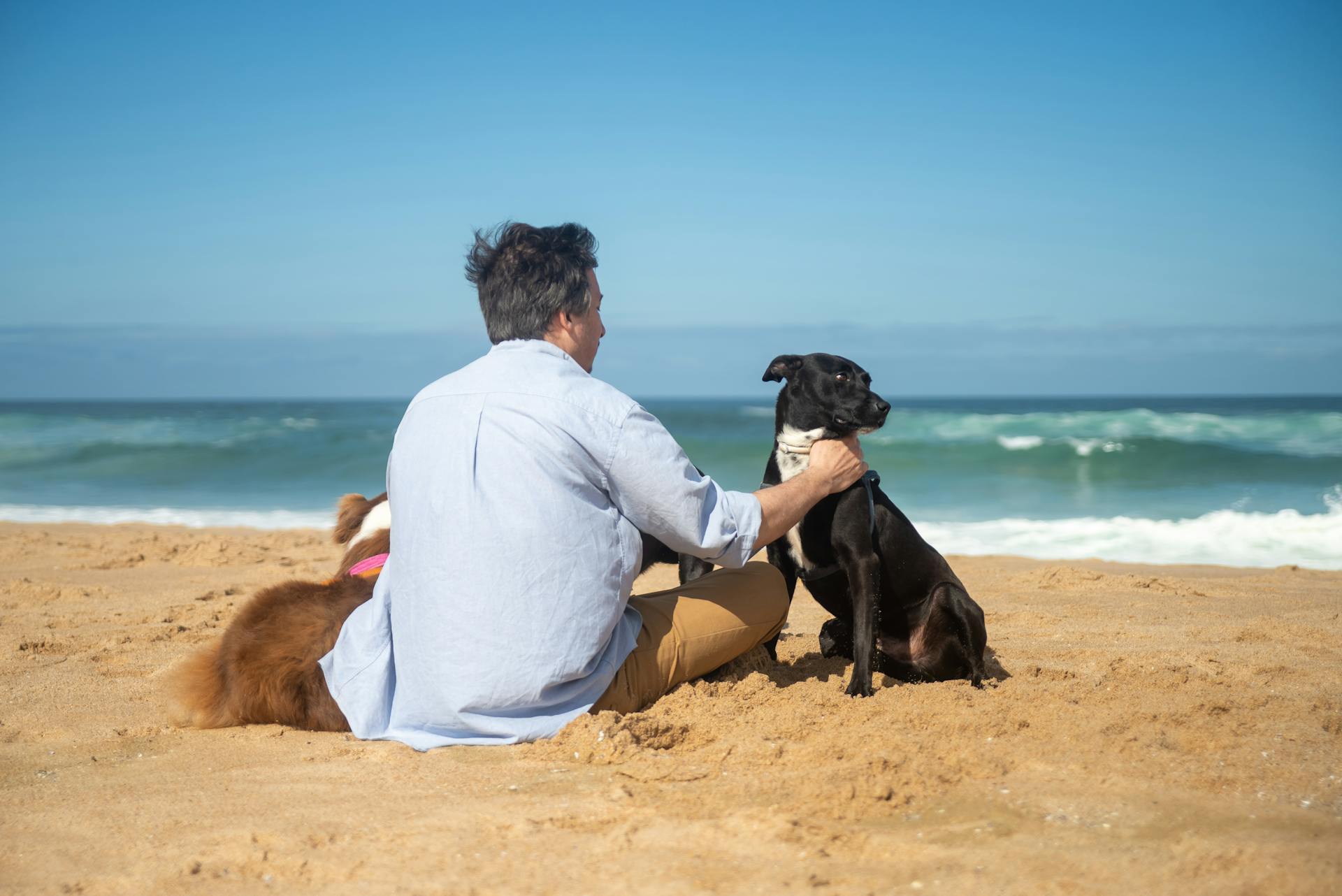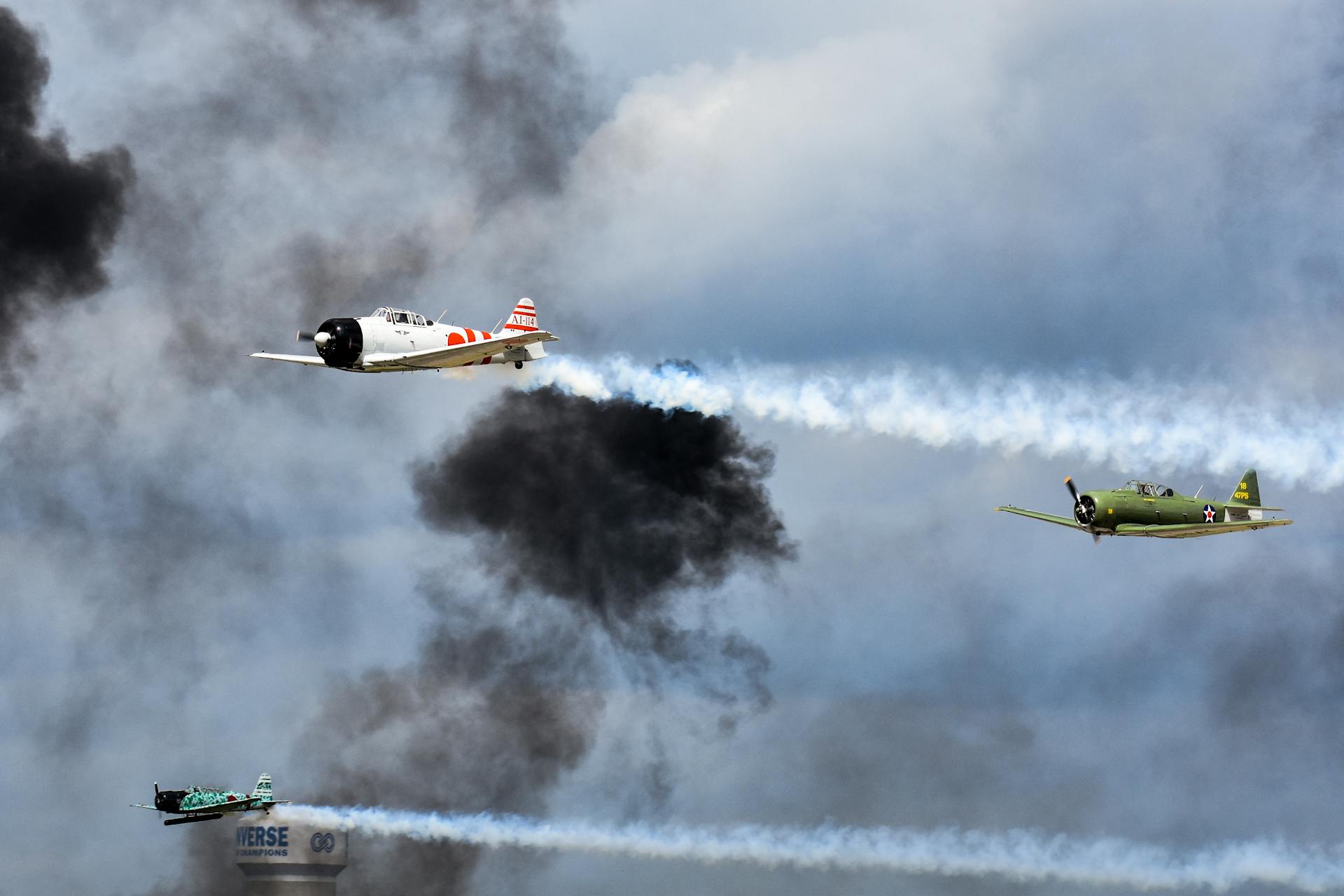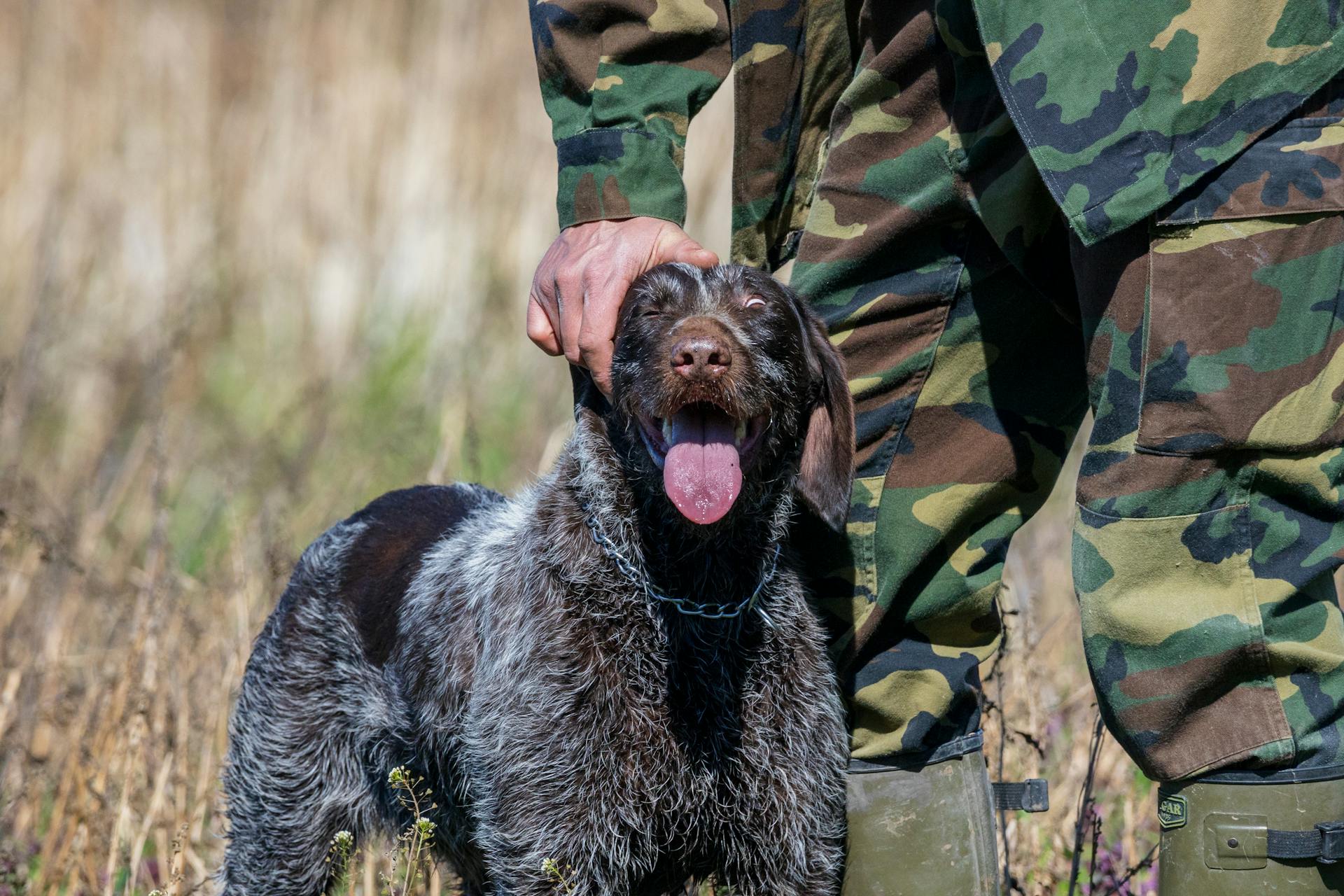
Dogs have been used in warfare for centuries, serving as loyal companions and valuable assets to military units. Their keen senses and ability to detect danger made them invaluable in combat situations.
Dogs were first used in ancient Greece and Rome, where they were employed as sentries and messengers. Today, dogs continue to play a crucial role in modern warfare.
Military dogs are trained to perform a variety of tasks, including detecting explosives and narcotics, providing emotional support, and locating missing personnel. Their training is rigorous and specialized, requiring a unique blend of physical and mental skills.
Dogs have proven to be effective in a range of environments, from urban to rural settings.
Expand your knowledge: Military Police Dogs
Military Working Dogs
Military Working Dogs are incredibly versatile and loyal partners in military police work. They can chase suspects, track them if they are hidden, and guard them when they are caught.
Many police dogs are trained in detection as well, making them valuable assets in a variety of situations.
Recommended read: Warfare Dogs
Police dogs are trained to respond viciously if their handler is attacked, and otherwise not to react at all unless they are commanded to do so by their handler.
Scout dogs, on the other hand, are trained to silently locate booby traps and concealed enemies such as snipers. Their keen senses of smell and hearing make them far more effective at detecting these dangers than humans.
The best scout dogs have a disposition intermediate to docile tracking dogs and aggressive attack dogs, making them well-suited for this type of work.
Scout dogs can identify the opposing threat within 1,000 yards of area, making them a valuable asset on the battlefield.
Consider reading: How Do I Become a Search and Rescue Dog Handler
History and Uses
Dogs have been used in warfare for thousands of years, with evidence of their use dating back to ancient civilizations such as Egypt, Greece, and Rome.
The Molossus dog of the Molossia region of Epirus was considered the strongest known to the Romans and was specifically trained for battle.
Dogs were often used as sentries or patrols, but were also taken into battle, as seen in the earliest recorded use of war dogs by Alyattes of Lydia against the Cimmerians around 600 BC.
Native Americans used dogs as pack animals and to pull travois, while Attila the Hun used giant Molosser dogs in his campaigns.
The Spanish conquistadors used armored dogs that had been trained to kill and disembowel natives, highlighting the darker side of war dog use.
Dogs were used to guard naval installations in France until 1770, and were also used by Frederick the Great and Napoleon as messengers during their campaigns.
The first official use of dogs for military purposes in the United States was during the Seminole Wars, and they were used to protect, send messages, and as mascots in American World War I propaganda and recruiting posters.
Hounds were used in the American Civil War to protect, send messages, and guard prisoners, and were also used as mascots in American WWI propaganda and recruiting posters.
In World War II, dogs took on a new role in medical experimentation, as the primary animals chosen for medical research.
See what others are reading: Wwii War Dogs
Today, dogs in military roles are often referred to as police dogs, or military working dogs (MWD), and are used for a variety of tasks, including detection work, patrolling, and law enforcement.
The most common breed for these operations has traditionally been the German Shepherd, but a shift has been made to smaller dogs with keener senses of smell and more resilient breeds for detection and patrolling work.
Dogs are paired with a single handler after their training, and the length of time with the dog and handler is crucial for building trust and effective communication.
On a similar theme: Police Working Dogs
Roles and Responsibilities
Dogs used in warfare have a range of roles, from detection work to patrolling and law enforcement. Traditionally, German Shepherds have been the most common breed for these police-type operations.
Their roles are varied, but they tend to be more rarely used in front-line formations. As of 2011, 600 U.S. MWDs were actively participating in the conflicts in Iraq and Afghanistan.
Suggestion: What Is Quellin Used for in Dogs?
Dogs are paired with a single handler after their training, and while a handler usually doesn't stay with one dog for the length of either's career, they often stay partnered for at least a year, and sometimes much longer. There must be trust between the two for things to work properly and smoothly.
The latest canine tactical vests are outfitted with cameras and durable microphones that allow dogs to relay audio and visual information to their handlers, enhancing their ability to detect and respond to threats.
Modern Uses
Modern uses of dogs in military roles are varied and have evolved over time. They are often referred to as police dogs, or in the United States and United Kingdom as a Military Working Dog (MWD), or K-9.
As of 2011, 600 U.S. MWDs were actively participating in the conflicts in Iraq and Afghanistan. This number highlights the importance of these dogs in military operations.

Traditionally, German Shepherds have been the most common breed used for police-type operations, but in recent years, there has been a shift to smaller dogs with keener senses of smell and more resilient breeds like the Belgian Malinois and Dutch Shepherd.
All MWDs in use today are paired with a single individual after their training, known as a handler. The handler's role is crucial in building trust with the dog.
The latest canine tactical vests are equipped with cameras and durable microphones, allowing dogs to relay audio and visual information to their handlers. This technology has greatly enhanced the effectiveness of MWDs in the field.
In the 1970s, the US Air Force used over 1,600 dogs worldwide, but personnel cutbacks have reduced USAF dog teams to around 530, stationed throughout the world.
Broaden your view: What Is Malotic Used for in Dogs?
Fighting
Dogs have been used in various ways for fighting, from ancient times to modern militaries. They were often strapped with armor and spiked collars and sent into battle to attack the enemy.
The Romans and Greeks were among the civilizations that used this strategy. In fact, the Romans even used dogs in their battles against the Gauls.
In modern times, SOCOM forces of the US military still use dogs in raids for apprehending fleeing enemies or prisoners, or for searching areas too difficult or dangerous for human soldiers.
The Soviet Union also used dogs for anti-tank purposes, beginning in the 1930s. They were fitted with tilt-rod mines and trained to run beneath enemy tanks, which would detonate the mines automatically.
However, the dogs were trained with stationary Russian tanks and very seldom ran under moving tanks, instead being shot as they ran beside moving tanks.
A fresh viewpoint: What Are Service Dogs Trained to Do
Sentries
Sentries were used to defend camps or other priority areas at night and sometimes during the day, alerting guards of a stranger's presence with a bark or growl.
During the Cold War, the American military used sentry dog teams outside of nuclear weapons storage areas.
A test program was conducted in Vietnam in 1965, deploying 40 dog teams to the perimeter of bases in front of machine gun towers and bunkers, which resulted in a rapid deployment of reinforcements upon detecting intruders.
The buildup of American forces in Vietnam created large dog sections at USAF Southeast Asia (SEA) bases, with 467 dogs eventually assigned to various bases.
Within a year of deployment, attacks on several bases had been stopped when the enemy forces were detected by dog teams.
Captured Vietcong told of the fear and respect they had for the dogs, and even placed a bounty on the lives of handlers and dogs.
The United States War Dogs Association estimated that war dogs saved over 10,000 U.S. lives in Vietnam.
Sentry Dogs were also used by the Army, Navy, and Marines to protect the perimeter of large bases.
Numerous memorials are dedicated to war dogs, including at March Field Air Museum in Riverside, California, and the Alabama War Dogs Memorial at the USS Alabama Battleship Memorial Park in Mobile, Alabama.
Check this out: Smoky (war Dog)
Logistics and Support
Dogs were used to pull small carts for milk deliveries and similar purposes in many European communities before World War I.
Several European armies adapted this process for military use, recognizing the potential of dogs to transport loads under fire.
The Belgian Army used dogs to pull Maxim Guns on wheeled carriages and supplies, or even wounded soldiers, in August 1914.
Two dogs of the Martin Belge breed were used to pull each machine gun or ammunition cart, and they proved hardier and more suitable for military use than packhorses.
The French had 250 dogs at the start of World War I, and the Dutch army copied the idea, having hundreds of dogs trained and ready by the end of the war.
Dogs were also used to drag wounded men to aid stations during World War II, a task they were well-suited for due to their ability to transport loads over snow and through craters.
Intriguing read: Dogs in the American Revolutionary War
Dogs were often used to carry messages in battle, requiring them to be very loyal to two masters to deliver the message on time.
Some messenger dogs also performed other communication jobs, such as pulling telephone lines or cables from one location to another.
A small Yorkshire terrier named Smoky was used to run a telegraph wire through a pipe to ensure communication without moving troops into the line of fire.
Detection
Detection is a crucial aspect of warfare, and dogs have played a significant role in this area.
Dogs have been used to locate mines, but they didn't prove effective under combat conditions. Marine mine detecting dogs were trained using bare electric wires beneath the ground surface, which shocked them, teaching them that danger lurked under the dirt.
The useful service life of these dogs was not long, as they were only able to work between 20 and 30 minutes at a time due to extreme nervousness. This is a result of variable schedule operant conditioning, which can be very extreme, even causing rats to huddle in the corner to the point of starvation to avoid electric shock.
Dogs have also been used to track fugitives and enemy troops, utilizing their olfactory skills to follow a scent. This is different from their role as scout dogs, where they would warn a handler at the initial presentation of a scent.
Trained MWDs can detect minuscule amounts of a wide range of explosives, making them useful for searching entry points, patrolling within secure installations, and at checkpoints. They can achieve over a 98% success rate in bomb detection.
Cultural Significance
Dogs have played a significant role in warfare, and their contributions have been celebrated in popular culture.
The 1944 song "I'd Like to Give my Dog to Uncle Sam" tells the story of a blind man who wants to enlist his service dog in the military during World War II.
Dogs have also been featured in several films that highlight their importance in military operations. Max (2015) tells the story of an American military dog rehabilitating into public life after his owner's death in combat.

Megan Leavey (2017) is a true story about US Marine corporal Megan Leavey and her military working dog Rex. This film showcases the strong bond between a soldier and their canine companion.
War Dog: A Soldier's Best Friend (2017) is a feature documentary that explores soldier-canine relationships during wartime. This documentary provides a glimpse into the lives of soldiers and their loyal companions.
Sgt. Stubby: An American Hero (2018) tells the fictional story of a stray dog who befriends an Army battalion during World War I. This film highlights the loyalty and bravery of dogs in the face of adversity.
Books have also been written about the experiences of dogs in warfare. One notable example is the story of Antis, a puppy rescued in WWII from no man's land in France by Czech fighter pilot Robert Bozdech.
Here are some notable films and books about dogs in warfare:
- "I'd Like to Give my Dog to Uncle Sam" (1944 song)
- Max (2015 film)
- Megan Leavey (2017 film)
- War Dog: A Soldier's Best Friend (2017 documentary)
- Sgt. Stubby: An American Hero (2018 film)
- Dog (2022 film)
- Books about Antis, a WWII rescue puppy
Research and Development
Dogs have been used in various forms of warfare throughout history, with their roles evolving over time.
In the early 20th century, dogs were primarily used for sentry duties, patrolling borders and detecting enemy movements.
The use of dogs in warfare gained significant attention during World War I, where they were employed for tasks such as messenger duty and detecting gas attacks.
The first military dogs were trained to detect and locate wounded soldiers on the battlefield, greatly improving medical response times.
The introduction of dogs in warfare also led to the development of specialized equipment, including dog harnesses and identification tags.
The US Army began training dogs for various military tasks in the 1940s, with a focus on obedience, tracking, and explosives detection.
For more insights, see: Dogs in Warfare News
Media and Representation
Dogs have been featured in various forms of media, often highlighting their roles in warfare.
The song "I'd Like to Give my Dog to Uncle Sam" from 1944 tells the story of a blind man who wants to enlist his service dog in the military during World War II.
Their stories have also been portrayed in films, such as "Max" (2015), which tells the fictional story of a military dog rehabilitating into public life after his owner's death in combat.
Here are some notable films about dogs used in warfare:
- Megan Leavey (2017) - a biographical film about US Marine corporal Megan Leavey and her military working dog Rex
- Sgt. Stubby: An American Hero (2018) - a fictional story about a stray dog who befriends an Army battalion during World War I
- Dog (2022) - a fictional story about an American Army Ranger who must escort his deceased partner's military dog to his funeral
In Popular Culture
In popular culture, military working dogs have been portrayed in various forms of media. The 1944 song "I'd Like to Give my Dog to Uncle Sam" tells the story of a blind man who wishes to enlist his service dog in the military during World War II.
This theme of military working dogs has continued in films such as "Max" (2015), which tells the fictional story of an American military dog rehabilitating into public life after his owner's death in combat. Another notable film is "Megan Leavey" (2017), which is a true story about US Marine corporal Megan Leavey and her military working dog Rex.
The HBO feature documentary "War Dog: A Soldier's Best Friend" (2017) also explores the relationships between soldiers and their canine companions during wartime. The film "Sgt. Stubby: An American Hero" (2018) tells the fictional story of a stray dog who befriends an Army battalion during World War I.

More recently, the 2022 film "Dog" tells the story of an American Army Ranger who must escort his deceased partner's military dog to his funeral. Books about Antis, a puppy rescued in WWII from no man's land in France by Czech fighter pilot Robert Bozdech, also exist.
Here are some examples of films and books about military working dogs:
- "I'd Like to Give my Dog to Uncle Sam" (1944 song)
- "Max" (2015 film)
- "Megan Leavey" (2017 film)
- "War Dog: A Soldier's Best Friend" (2017 HBO feature documentary)
- "Sgt. Stubby: An American Hero" (2018 film)
- "Dog" (2022 film)
- Books about Antis, a puppy rescued in WWII
Gallery
In the gallery of media and representation, we see the incredible work of military working dogs. They search for wounded men through scent and hearing.
These dogs are trained to perform a variety of tasks, including drawing machine guns, as seen with Belgian dogs. Their skills are put to the test in real-world scenarios, like the German Bundeswehr dog demonstration.
Military working dogs are also trained to withstand loud noises, such as blank ammunition fired by Navy Master-at-arms. This is crucial for their ability to perform their duties effectively.
In Afghanistan, U.S. Air Force Security Forces dog handlers work alongside their German Shepherds. These dogs are an integral part of the team, providing security and support.
On a similar theme: Dog Work

Some of the most impressive images come from the U.S. Naval Security Force K-9 Unit training. Here, we see the dogs in action, performing tasks that require precision and focus.
Here are some examples of military working dogs in action:
- Ambulance dogs search for wounded men through scent and hearing.
- A U.S. soldier and his Labrador Retriever dog wait before conducting an assault against insurgents in Buhriz.
- A U.S. Army working dog, a German Shepherd, wearing body armor clears a building in Afghanistan.
- A Special Forces operator in Syria alongside a SF Multi-Purpose Canine provides security for a nearby mortar position during the Deir ez-Zor campaign, October 11, 2018.
Frequently Asked Questions
What is the most famous dog in war?
Stubby, a stray dog from Connecticut, is widely regarded as the most famous war dog in history, serving with the 102nd Infantry Regiment in World War I. This heroic canine's incredible story is now on display at the Smithsonian Institution in Washington D.C.
Sources
- https://www.ausa.org/articles/ruff-and-ready-military-working-dogs-serve-unique-roles
- https://military-history.fandom.com/wiki/Dogs_in_warfare
- https://www.army.mil/article/56965/military_working_dogs_guardians_of_the_night
- https://en.wikipedia.org/wiki/Dogs_in_warfare
- https://www.army.mil/article/7463/war_dogs_the_birth_of_the_k_9_corps
Featured Images: pexels.com


